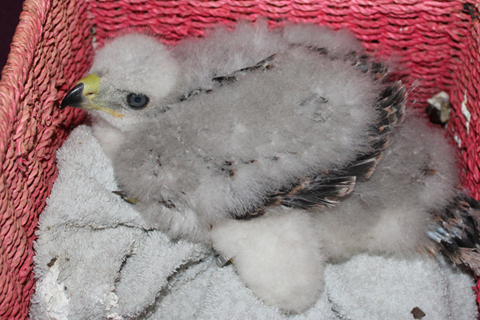Nest robbery
Nest robbery is a serious threat to our feathered friends, and it can take several forms:
- Taking eggs for collecting purposes
- Taking eggs or nestlings for falconry or bird keeping
- Robbing nests for food (mostly sea- and waterbirds)
- Climbing or felling trees during breeding season to collect juvenile birds from nests

Northern goshawk chick taken from nest /ordered by falconers/ (Police.hu)
There is also a practice called nest destruction: when the nest or its content is destroyed without taking the eggs or the nestlings – whether it’s intentional or not. This is type of persecution is also illegal, and is often perpetrated against species that some call “nuisance species” or “pests”.
What is driving nest robbery?
Egg collection and trade
Criminal collectors steal eggs from wild clutches to build collections of different species and trade with one another. Rare breeding species are particularly vulnerable to egg collectors. Depending on the area, different species are more threatened than others. In Kenya, for instance, owl egg collection is said to be the easiest wildlife crime as no shots are fired. The trade of these eggs is highly lucrative, as the price of one owl egg is said to be twice the price of a rhino’s horn.
Breeding
Some collectors steal eggs or chicks from nests in the wild. Many species are difficult to breed in captivity, providing an incentive to take eggs or fledglings directly from the wild and to raise them in aviaries; falsely claiming they were bred in captivity. Eggs and very young birds are the most wanted as the small chicks can still be fitted with closed foot rings. Closed foot rings are used by legitimate breeders to prove the origin of their birds, however, illegally acquired wild birds are often fitted with counterfeit rings so that the perpetrators can claim they were legally bred in captivity.
Food
Seabird colonies and waterbirds are sometimes targeted by thieves to eat or to sell the eggs as food.
What does the law say?
The protection of naturally occurring wild birds is expanded to their eggs, nests and habitats under the EU Birds Directive and the Bern Convention. The taking of eggs or chicks is a serious matter: it has contributed to the decline of several bird species. This practice has been outlawed in most European countries since last century.
In the Middle East, legislation covering wild birds also extends to their nests in most countries. However, due to the huge sums of money involved in falconry in this region, it is often a destination for robbed nest goods. The black market for birds of prey fuels nest robbery in other regions which are then smuggled into the Middle East.
What can you do to help?
Please report all suspected bird crime to the police and to your local BirdLife partner. Here are signs that might indicate nest robbery: traces of climbing gear, trampled vegetation around the tree, broken twigs. Sign indicating nest shooting could be pellet traces on twigs, nest material or the trunk.
Assessing the origins of captive birds can be complex. In most cases, special permits and documentation is required, but this is not always the case. If you see wild birds for sale on social media or in shops without a closed foot ring, please report it to the relevant authorities.
If you record an easily accessible nest on a citizen science platform, you might want to blur the location – making it harder for the thieves to find.
